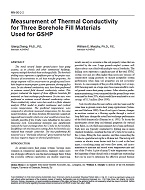Description
The trend toward larger ground-source heat pump systems, as in schools and other commercial buildings, requires multiple borehole heat exchange fields. The borehole drilling costs represent a significant part of the project cost. Because of uncertainties in soil heat transfer properties, the design engineer will be conservative in specifying total bore-hole length to ensure proper system operation, driving up first costs. In-situ thermal conductivity tests have been performed to estimate actual field thermal conductivity values. This project evaluated the impact of three different borehole fill materials on heat exchange performance. In-situ tests were performed to estimate overall thermal conductivity values. These conductivity values were then used in a finite element analysis (FEA) model to predict continuous and cyclical system temperatures. The predicted temperatures were compared to downhole measured temperatures for the same tested boreholes. All three borehole fill materials negatively impacted heat transfer relative to what would have been theoretically possible if the U-tube were imbedded in the native limestone rock. Conventional bentonite clay significantly reduced the heat exchange from the U-tube in the borehole. Backfilling with the limestone cuttings from the borehole also reduced heat transfer somewhat. The best performing fill material was a “thermally enhanced” grout material that had the least negative impact on thermal performance.
Units: Dual
Citation: Symposium, ASHRAE Transactions, vol. 106, pt. 2
Product Details
- Published:
- 2000
- Number of Pages:
- 8
- File Size:
- 1 file , 240 KB
- Product Code(s):
- D-7242




